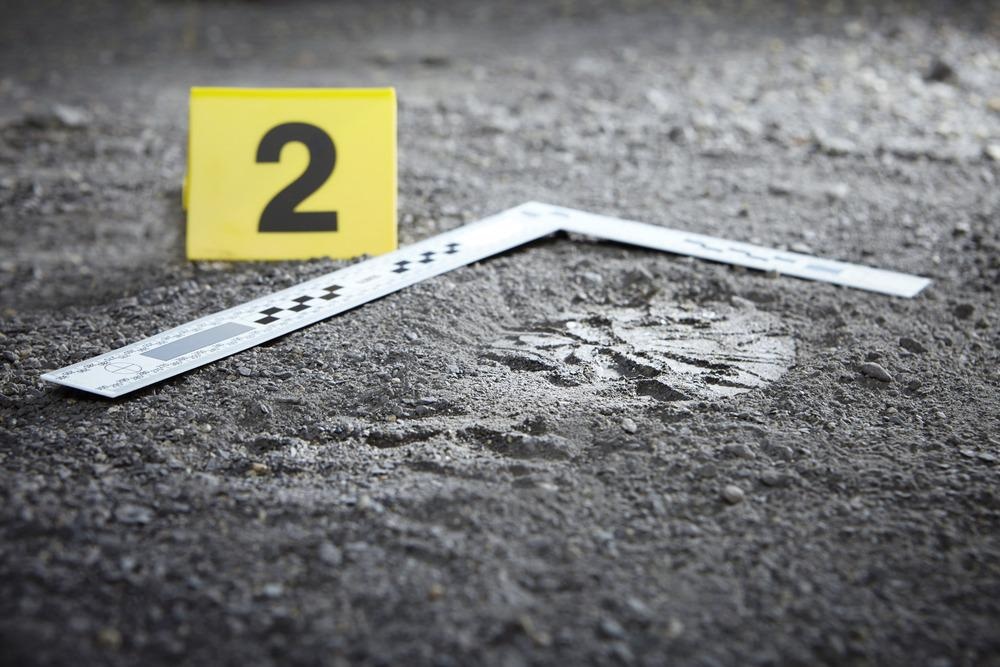During the mid-1980s, the serial killer known as the Night Stalker was active in California. The case gained extensive media coverage due to the nature of the crimes and the apparent inability to get any leads on the perpetrator. His footprint, as it turns out, was the pivotal piece of evidence that helped link law enforcement to Richard Ramirez. The high-profile case of the Night Stalker and its use of pedal (relating to the feet) evidence helped to put forensic podiatry on the map.

Image Credit: Couperfield/Shutterstock.com
What is forensics gait analysis?
Footprints and shoe prints are often left at crime scenes and can be used to help investigators find leads to suspects, exclude or include certain suspects in inquiries, and give indications to what happened at the crime scene. As well as using shoe prints to determine the shoe size and make of a suspect, which can lead to other clues such as a person’s height and gender, their gait can be determined from the pattern of prints, revealing more vital information about the suspect, or, sometimes the victim also.
A specific field of forensic science has emerged to deal with these analyses, it is known as forensic podiatry. The discipline aims to associate an individual with a crime scene using knowledge of their feet, footwear, or functioning of the foot.
Pedal crime scene evidence can take many forms: the footprint of an intruder left in the mud beneath an open window, a footprint left in a victim’s blood, CCTV footage of an unknown person walking away from the scene of the crime, these are just some of the types of evidence that are assessed by those involved in forensic podiatry.
In this article, we will focus on how gait analysis is gathered from this type of evidence in order to help criminal investigations.
Surface vs video gait analysis
A person’s gait refers to their patterns of limb movements made when walking or running known as a ‘gait cycle’. The gait cycle is made up of two distinct phases, the stance phase, and the swing phase. The stance phase consists of five sub-phases: initial contact, loading response, mid-stance, terminal stance, pre-swing. The swing phase consists of three sub-phases: initial swing, mid-swing, terminal swing. Forensic podiatrists use pedal evidence to establish the nature of these phases and sub-phases that are unique to the individual to make assumptions about the person who left the evidence.
Gait analysis can be conducted in two main ways, analyzing footprints left on a surface, or analyzing a video of a person walking. Gait analysis of footprints requires at least three of four footprints left in succession. The analyst considers various factors such as the dimensions of the footprints, their shape, and margins, toe marks (if the print is barefoot). Additionally, measurements are taken relating to the person’s stride which can help establish the nature of the gait pattern.
For example, analysis can determine if a person was running or walking when they left the print, it can also indicate the sex, age, stature, and weight of the owner of the set of footprints. It can also highlight any abnormalities such as illnesses or injuries that may affect a person’s gait. From these analyses, a profile of the person who left the prints (usually the perpetrator of a crime) is produced. This profile is then compared against the profile of a suspect to determine a match by systematically comparing analyzing and scoring the patterns. This evidence may be entered into court, depending on the country or state, but it is often only permissible as supplementary evidence alongside other forms of evidence.
Gait analysis from video footage, usually obtained from CCTV but increasingly from other sources such as video cameras, mobile phones, and dashboard cameras, is a newer area of forensic podiatry and it has given a new dimension to gait analysis. Previously, eye-witnesses may have given investigators an interpretation as to how they perceived a perpetrator's walk or run. However, as with all eye-witness testimony, it is subject to the failings of memory, eyewitness bias, and other factors which reduce its accuracy.
With gait analysis of video footage, the features of a person’s movements can be used to make various assumptions about the perpetrator, such as is possible with surface gait analysis. Also similarly to surface gait analysis, conclusions drawn from video analyses cannot be entered into court as the sole evidence.
However, it is recognized (as is surface gait analysis) as important evidence with strong scientific backing. Therefore, modern criminal investigations focus on considering all sources of video evidence that may exist, such as CCTV, surveillance footage, traffic camera footage, dash-cam footage, mobile phone recordings, as evidence for gait analysis.
Currently, a single methodology of gait analysis for either surface or video sources exists. Usually, analyses are subject to the expertise and experience of the team conducting the forensic podiatry investigation. This field of forensic science may become more important in the coming years, although this would depend on advances in technology that would allow for more assumptions to be made from gait analysis or strengthen the accuracy of these assumptions.
Sources:
- Krishan, K., Kanchan, T. and DiMaggio, J., 2015. Emergence of forensic podiatry—A novel sub-discipline of forensic sciences. Forensic Science International, 255, pp.16-27. https://pubmed.ncbi.nlm.nih.gov/26163192/
- Mukhra, R., Krishan, K. and Kanchan, T., 2018. Bare footprint metric analysis methods for comparison and identification in forensic examinations: A review of literature. Journal of Forensic and Legal Medicine, 58, pp.101-112. https://pubmed.ncbi.nlm.nih.gov/29777981/
- van Mastrigt, N., Celie, K., Mieremet, A., Ruifrok, A. and Geradts, Z., 2018. Critical review of the use and scientific basis of forensic gait analysis. Forensic Sciences Research, 3(3), pp.183-193. https://pubmed.ncbi.nlm.nih.gov/30483668/
Further Reading
Last Updated: Feb 25, 2022